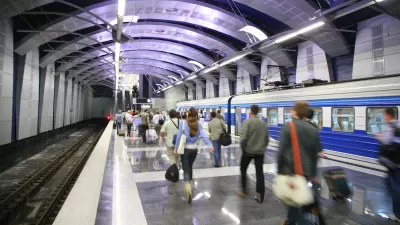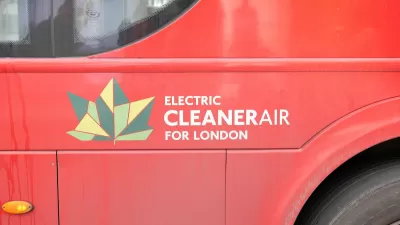A new study concludes that not only is transit a safer way to travel, but communities oriented around transit are also safer. As a result, planning approaches that encourage transit also increase traffic safety.

A new report [pdf] from the American Public Transportation Association looks at the relationship between public transit and traffic safety. The United States compared to peer countries ranks highest in terms of per capita vehicle mileage and traffic death rates. Among U.S. cities, the traffic fatality rate decreases as the number of per capita transit trips increases.
Angie Schmitt describes the report’s conclusion that factors related to public transit also increase traffic safety:
Transit is not only safer for the obvious reason — trains and buses are safer than cars — but because communities built around transit tend to have safer walking and biking amenities, fewer parking lots and safer street design. Such features, as well as higher population density, make it easier for people to make shorter car trips, or avoid them all together — reducing their overall exposure to crashes.
In addition, alternatives to driving, such as more available transit, promote less driving by high-risk groups, including youth, seniors, and alcohol drinkers, says APTA.
"APTA hopes the study will encourage increased transit funding. But the group also calls on cities and institutions to develop incentives — such as discounted fares — and disincentives, such as charging for parking by the day, to encourage drivers to switch to transit," reports Schmitt.
FULL STORY: The Best Tool for Reducing Traffic Deaths? More Transit!

Alabama: Trump Terminates Settlements for Black Communities Harmed By Raw Sewage
Trump deemed the landmark civil rights agreement “illegal DEI and environmental justice policy.”

Study: Maui’s Plan to Convert Vacation Rentals to Long-Term Housing Could Cause Nearly $1 Billion Economic Loss
The plan would reduce visitor accommodation by 25% resulting in 1,900 jobs lost.

Planetizen Federal Action Tracker
A weekly monitor of how Trump’s orders and actions are impacting planners and planning in America.

Wind Energy on the Rise Despite Federal Policy Reversal
The Trump administration is revoking federal support for renewable energy, but demand for new projects continues unabated.

Passengers Flock to Caltrain After Electrification
The new electric trains are running faster and more reliably, leading to strong ridership growth on the Bay Area rail system.

Texas Churches Rally Behind ‘Yes in God’s Back Yard’ Legislation
Religious leaders want the state to reduce zoning regulations to streamline leasing church-owned land to housing developers.
Urban Design for Planners 1: Software Tools
This six-course series explores essential urban design concepts using open source software and equips planners with the tools they need to participate fully in the urban design process.
Planning for Universal Design
Learn the tools for implementing Universal Design in planning regulations.
Caltrans
Smith Gee Studio
Institute for Housing and Urban Development Studies (IHS)
City of Grandview
Harvard GSD Executive Education
Toledo-Lucas County Plan Commissions
Salt Lake City
NYU Wagner Graduate School of Public Service





























